dmx
aka. Flashman, Drumtex, Lloyd Rosen, lloyd, llyode, dmx, dmx87
This is an ongoing reconstruction of my retro computing history. Continue at your peril.
1986 - 1988
I got my first Commodore 64 in 1986, exclusively used for playing games. After losing at some game one time too many, I bricked it in a fit of anger. It wasn't until Christmas 1987 that I was so lucky — or spoiled — as to cry myself to another C64. This time I had learnt my lesson, and never smashed a computer again.
This period was a hardship for a little boy with an insatiable lust for gaming. I remember trying to copy turbo-tapes on my older brother's double-decker (and before you try, no, it rarely works), spending ages turbo taping games, and even bought tapes from personal ads in magazines. I recall my best friend, who also owned a C64, and I travelled a long long way on our bicycles to the only computer shop in town to buy what he could afford, and all we got was Fruity, and no t-shirt. It was really disappointing.
However, the interest in games morphed into curiosity of the machine itself. Maybe the lack of new games was what drove me to it? Before long I was able to write my first simple text adventure game in BASIC. IF COMMAND$ = "GO NORTH" THEN...
One of my C64 friends, Starman (no groups, I guess - can not find him on csdb), was one of my town's few swappers who had lots of new games. But he also had a bunch of these not-games called "demos", which piqued my interest.
In short order, my attention turned rather abruptly off games onto this new thing called demos from this new, abstract world known as "The Scene".
I started experimenting with music, by changing bytes in a music player by Michael Winterberg before moving briefly on to Chris Hülsbeck's legendary Soundmonitor.
1989 Flashman
In May of 1989, I had made my first real tune in SoundMonitor, and even released it to the world. It was called Gog's Child. Who is Gog, and what's the deal with their child? Absolutely no idea.
With the release of this tune, I'd chosen the hard-hitting handle Flashman to represent myself as an authority in the Scene.
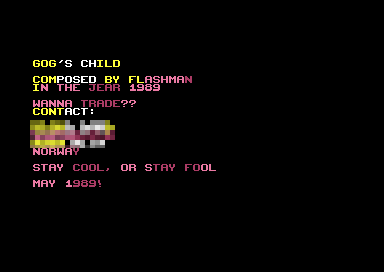 (In the JEAR? I hope that was deliberate.)
(In the JEAR? I hope that was deliberate.)
My interest in the demoscene grew by the day, and on one of my swap-disks I came across Soundmaster by SödeSoft. It was a music editor that allowed creating pro-sounding music, just like the ones you'd hear in demos. To me, this was a revolution.
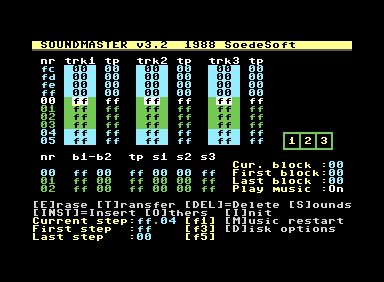
At the time I had inherited a big, fat, old early-80's TV from my parents. I was glued to it's 28" screen most of the day. Maybe that's why my eyesight is shot? It had such a tiny speaker - I couldn't even hear samples! There was almost no difference if filters were used or not — everything was muffled to the unrecognizable anyway. You can hear the result of this filter weirdness in my early tunes.
I remember I once went to my friend, Cray, who had an 1081 (or 1084?) monitor, and I could actually hear the samples of Jordan vs. Bird: One on One by Rob Hubbard - I could not believe my own ears!
After seeing a production of one of the quite new, but already pretty famous Norwegian demogroup Megastyle Inc's, I applied for membership - which was done by carefully writing a nice letter and posting it by mail. For no apparent reason I got accepted as member in July 1989. My music was generally lackluster, but I like to pretend the crew heard a smidge of potential.
A direct consequence as the latest member of MSI, was that it became super easy getting swapping contacts with just about any elite groups in the scene! Swapping, if you don't know, is the act of copying software onto floppy disks and sending them by mail to a contact, who in turn returns the favour. "Return stamps!," they'd threaten. Well, they'd better return the favour, or there could be WAR! (Cringe!)
Scroll of Megastyle — in my humble opinion one of the C64's best coders of all time — hacked Maniacs of Noise's Stormlord music player and made a custom editor for it, called Audiomaster, which looked like this:
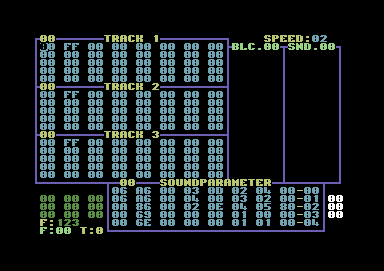
The interface (I've seen the term Hypertracker coined recently to describe this) was very much inspired by Future Composer, the most popular music-editor on the C64 at the time. Scroll coded this editor in a monitor, not assembler. An amazing feat of true hackery, as a monitor is even closer to the hardware, editing memory directly. So, the binary is the sourcecode. Side-note: Jeff Minter and many other early programmers used monitors to develop their wares. Even Rob Hubbard composed much of his music directly in a monitor!
Drumtex
There were, ironically and very much virtually, too many "-men" in the scene those days. So I came up with a new handle, Drumtex, which just was a combination of some random words I had put on paper. I made a bunch of songs in both Soundmaster and Audiomaster. Some were used in Megastyle demos, most remained unused. Listening to them now, they all pretty much sound the same. I could create several "tunes" in a day, re-using a lot of the sounds.
During this time I was swapping demos and feeling envious of the crisp sound of other musicians like JCH, Johannes Bjerregaard, Drax, JO, Maniacs of Noise, 20CC... The desire to create more advanced sounds than the SID (aka. 6581, the C64's sound-chip) could produce was almost overwhelming. Today, authentic SID- (or chip-)sound is a virtue in itself, but in those days we wanted more — much more.
Now, the spoiled brat in me had no qualms about complaining that Audiomaster was too hard to use, and that I'd prefer something tracker-based instead, like Soundmaster above. I remember I wrote this in a "note-writer", a popular form of communication on the C64 where you'd type a letter, save it to disk, and the recipient could watch the text be typed out just as it went in, mistakes, corrections and all.
I hope for the challenge, rather than my complaining, Scroll got down to business and hammered out the sequel, aptly named Audiomaster 2
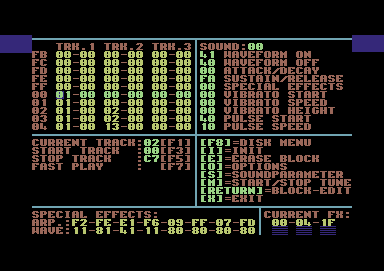
He wrote his own player for it as well, and again all in a machine-code monitor! At the same time, Megastyle also formed a "music-group" named Jolly Poppers in November. Music-groups were popular at the time, after the success of the likes of W.E.M.U.S.I.C (arguably the first, back in 1987), 20CC, Maniacs of Noise, Lords of Sonics, and Vibrants. Just like today, everyone and their dog were convinced they could do music, and game music in particular.
1990 Enter the Amiga
Sadly, I don't think I ever made any music with Audiomaster 2, because by then, the temptation of the Amiga had overcome me. After the summer of 1990 I replaced the C64 with an Amiga 500 and immediately started building a contact network for swapping demos and games, using my membership in MSI as a springboard. I also picked up making music using the famous Noisetracker by Mahoney+Kaktus:
![]()
In 1991, Protracker arrived. It quickly came to dominate the music scene, and had a virtual monopoly on demo music over the next few years.

Mildly interesting anecdote: At the Cryptoburners' Amega party in june 1991, my friend Rancor and I approached Lars Hamre, the author of Protracker 1.1b, questioning how the splash image (the Protracker info page above) was encrypted. Lars told me it was not actually encrypted, just byte-run encoded to save space. And he proceeded to copy over the encoding routine to a disk and handed it to me! Not long after, we replaced the image and released "Protracker 1.1c". I'm sure it ended up in someone's collections, but the only difference was the version number.
I also learned assembler programming on the 68000, in the hope of creating demos and games. In the summer of 1991, my friend Caustic and I xeroxed two copies of the Amiga Hardware Reference Manual at our school. About 800 pages in total! His father was a teacher, so the keys to the school were — let's just say — "available."
I also applied and was accepted into a few demo groups at the time, of which I can recall: A short stint in Exit (until June 1991), Cytax in July/August 1991. The Cytax page doesn't mention me as a member, but I did the tune for the diskmag I.C.E. 5 released in August 1991. Deadline from early 1992. No proof here. I didn't produce any released music in this period, except for the I.C.E. 5 music.
Not exactly pinnacles of the scene (no offense!) In contrast, Rancor went on to join world-famous groups like TRSI, Scoopex and Absolute!
I have recently created a page with a selection of some of my Protracker modules from 1991-1993 if you'd like a listen to products of it's time.
1992 Lloyd Rosen, Lloyd
I rehandled myself Lloyd Rosen (Rosen after Ron Rosen, author of the Atari/C64 game Mr. Robot, which I later did a remake of). Over the years it devolved into lloyd and llyode. I still use those from time to time.
Briefly, I released a diskmagazine called Resident Magazine (tagline: This one stays in YOUR memory) in June 1992. We got access to Usenet through my friend Kris' father at the university were he worked, and so we were able to spam a few newsgroups. I remember we got negative remarks about this. Sorry, we were young and didn't know proper netiquette! Here's a link to one of the messages we spammed with. My friend Cray coded the first engine. An anti-virus organization called Safe Hex International (geddit?) in the US wanted to work with us on this magazine. Issue two was written by entirely by Safe Hex International, and was full of swearing in contents of generally shabby quality. So I regained control by issue 3 (1993) and wrote the engine myself. After issue 4 in September 1993, the magazine was dead. I still have the source of issue 5 lying around, very incomplete.
I also wrote an address-book / phone list utility called AdPerfect, which can be found on Aminet.
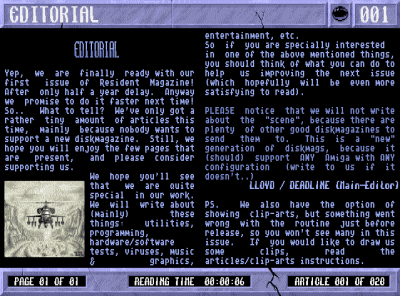
1993 Revisiting the C64
A friend of mine offered me his C64 for real cheap - only 500 NOK with a disk-drive and joysticks, and I jumped at it. I finally learned 6502 assembler properly, created a tiny game (Holy Camels!), the beginnings of a demo, all in Turbo Assembler. I also composed a few songs in Music Assembler. But interest waned, as the C64 was pretty much dead by then anyway. It's not called the Desolate 90s for nothing, baby. I kept the C64 in storage this time.
1994
In 1994 (maybe 1993? check up on that) an artist friend of mine, Rhino and I applied for work at Funcom, but was turned down. I laugh thinking about it today. They had the legend Jeroen Tel himself onboard! Rhino was an art-naturale, very good at it. I don't know what became of him, but wouldn't surprise me if it's creative (Update: I learned he's a photographer, so indeed creative.) I did code a playable, but never finished or released, Zenji remake called Zenzer.
1995 A2000
1995 was a year mostly off computers, while I dedicated myself to girls, partying and playing bass and guitar in a band. I continued to play in bands up to 2013. The last band was called Rebel Android which is why I own this domain.
Computing wise, I got an A2000 with an (unused) XT board in this period. It was sporting a 52 meg harddrive, only 7 of them available, for some reason.
1996 A600, A1200
Somehow I bought myself an Amiga 600 in 1996. I remember working on several projects that never came to be, one of them a Wizard of Wor inspired game. I haven't found a trace of that in my archives. There was something called TALE (The Adventure Language Executor) which was an unfinished text-adventure game engine.
Quite some work was done on a "Bruce Lee II" for the Amiga - a separate page is coming up on that.
I wrote two music editors, so I wasn't completely useless. From the source logs, I can see I got an A1200 by November 1996. Both the A600 and A1200 is still in storage, and I've been wondering for a long time how the A1200 even came into my hands.
1997 High Noon
I finally finished something; a "port" of the C64 game High Noon, under the "company name" Seasons (Chris Cornell, R.I.P.) Here's a video of someone playing it:
Seems like it has a bug that makes it freeze at the fourth wave. A shame, because there's actually a fifth wave with a showdown outside a cave. Note the strange way the undertaker walks. I had no idea how to do a proper line algorithm, so I devised a strange random line-ish walk thing. I now find it adds a bit of positive "quirk" to the game. I also wrote my own music player for this game, of which I was rather proud.
I've put up a page about the High Noon remake which also has the original sourcecode. If you find the bug, let me know :)
My friend Alex had an internet connection at the Uni and uploaded the game to Aminet under my real name by mistake. Years later, I tried to have it corrected to "Lloyd Rosen", but the maintainer was very suspicious about the whole thing and rudely refused. It wasn't until 2005 or so that they finally caved in and changed it.
Speaking of music players. Now that I think of it, this was another desire in the C64 and Amiga days: new music routines. Anything that was different than the Protracker module format everyone was using. I spent countless hours disassembling and researching players and editors (Fredplayer, David Whittaker, Maniacs of Noise, Brian Postma's Soundmonitor, etc.) and also trying to come up with my own.
1998 To Be or not to Be
Some AHX songs (SID sound on the Amiga) which you can listen to here were composed before I moved to Oslo.
The Amiga was on it's dying breath. First refusing to ever let go, I finally gave in about five years too late, and built my first PC in 1999 (maybe even 2000?)
I initially built it to use BeOS, an up and coming operating system inspired by the Amiga. But the lack of quality software quickly propelled me over to Windows 98. I stayed on Windows until I installed Fedora on my main laptop in 2023.
I still had my C64 (and to this day!), and wrote some reviews of some new tunes at the time, at the behest of Megastyle's Shokray. One of "The Crest" magazines, I've to look up which one.
2000 Windows
An online buddy of mine, pluki and I had some game ideas, but stuff never amounted to anything except an offensive demo that was never released. It was a novel puzzle game called Loads-a-Balls, a concept I still think fondly of. I also worked on another adventure game engine at the time called MADCAP, started on the Amiga and later continuted on the PC. Here's a picture with obviously ripped graphics:
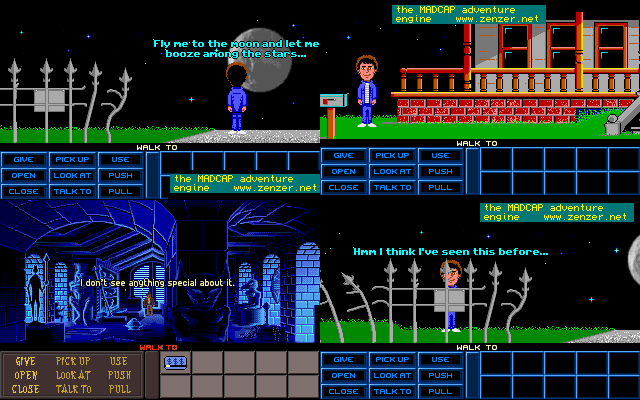
We had an idea of spoofing of the X-Files, which we wanted to call the — wait for it — Z-Files. It was too much writing, not to mention we had no graphics artist anyway, so the idea fizzled out.
(Many years later, Ron Gilbert of Maniac Mansion fame did basically the same idea, in the shape of Thimbleweed Park.)
The above image is taken from a 2D indie developer site I was the webmaster of, called 2DNow (2002 - 2005). Remind me, someone, to convert the posts to text and publish them, for historical purposes.
We also had other vaguely defined projects, like an Advance Wars clone, a RISK-like strategy game and so on. Nothing came to fruition. A lot of time was sunk in writing tools and engines and libraries, and not nearly enough effort went into the actual games themselves, which is a recurring theme of my hobby game development history.
2004 Maniac Mansion
Christmas at my parents house, had no internet. So I decided to disassemble as much as I could of Maniac Mansion and wrote down some specs and the beginnings of an emulator for it, which became the basis for the ScummVM implementation of the C64 Maniac Mansion emulator. ScummVM credits - See "special thanks" Lloyd Rosen for deep tech details about C64 Zak & MM.
I called it Scummel, and here's a screenshot of what it looked like. The picture lies a bit; it looks complete, but there were no actor animations, and lots of other stuff missing. But I was satisfied.
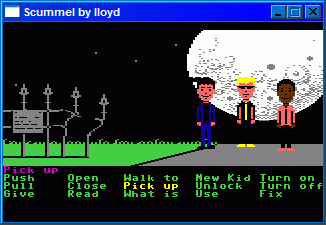
... Time passes, while Lloyd goes into boring business programming ...
2016 Back into it
The retro itch came back, so I rejoined Megastyle. Time was spent mostly idling about, but I managed to produce some tiny music for some productions: Lumberjack (2016), Spikes (2018), Tacky (2018), Vector Runner (2018), Captain Cloudberry (2017), Trump Tower (2018), and a little Psytronik Intro ditty for Mancave / Docster's Digger
I also did a remake of Mr. Robot for Windows. Reverse-engineering my favourite C64 game was also a pastime over a period of two years.
2019 Return of Fury
1st of March I was finally ready to release Bruce Lee - Return of Fury for the C64.
In the end of the year I left Megastyle and released Bruce Lee Duology as my final C64 project.
Although, is anything really final?
Present Day
It's probably strange for "outsiders" to hear that fascination for this little computer, the C64, keeps going from strength to strength.
I still research old C64 games, hack on them, create and listen to music, watch demos, read interviews, follow the community, and so on.
It's my mental yoga, meditation, mindfullness, my zen.
In the weekends, I can often be found roaming retro Twitch channels under the handle dmx87 (I was not born 1987, but it is a year I have fond memories of.) I even stream a bit of retro myself by playing, unintendedly badly, obscure C64 games, but also some classics.
If you spot me around, do say hello :-)
All said and done, I'm just a "has-been", forever stuck in the past.
But it feels so good.